|
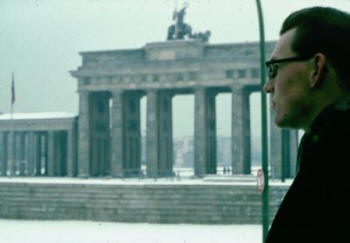
Elder Southwick at the Brandenburg Gate in Berlin, Germany in
1962
Observing the Building of the Berlin
Wall in Berlin, Germany
(Control the sound)
I was an eye witness to the building of the Berlin Wall. It
caused me to think deeply about political strife. During the early 1960's I served as an
 American missionary for the
Church of Jesus Christ of Latter-day Saints in Germany. In July 1961 I was
transferred to West Berlin and stayed there for about 20 months. It was the time of cold-war political tension. Germany was divided in two by the
"iron curtain:" Communist East Germany (Deutsche Demokratische
Republik) on one side and free West Germany
(Bundesrepublik Deutschland) on the other side. American missionary for the
Church of Jesus Christ of Latter-day Saints in Germany. In July 1961 I was
transferred to West Berlin and stayed there for about 20 months. It was the time of cold-war political tension. Germany was divided in two by the
"iron curtain:" Communist East Germany (Deutsche Demokratische
Republik) on one side and free West Germany
(Bundesrepublik Deutschland) on the other side.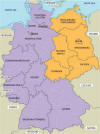 The capitol city of Berlin was located in the middle of East Germany and was itself divided
into four zones (American, British, and French zones in the western half, and
Russian zone in the eastern half). The capitol city of Berlin was located in the middle of East Germany and was itself divided
into four zones (American, British, and French zones in the western half, and
Russian zone in the eastern half).
My transfer from a city in West Germany to West Berlin was
by train. I was a bit apprehensive when the train made its first stop after
crossing the border into East Germany, but I had to smile when the
stationmaster announced that all refugees wanting to defect to East Germany
were invited to leave the train and report to a certain location in the
train station. I didn't see anyone get off the train. The border between
east and west Berlin was open for a few weeks after I arrived. On a Saturday
(August 12, 1961), my companion and I visited East Berlin, where we bought some
books. When we took the subway back to our apartment,
I noticed how crowded the subway was. Tension was high as East Berlin police
walked up and down the subway station, looking at the passengers, many of
whom had suitcases. The next morning our German acquaintances were nervous
and agitated about news that the the borders around West Berlin had been
closed by the East Germans. It
didn't make much sense to us Americans. So the next evening (August 14th,
1961) after dark, we tried to visit the Brandenburg Gate where some of the disturbing actions were supposed to be
happening. We avoided the rowdy noise from protesters along the street leading to the Brandenburg Gate
(Straße des 17. Juni). We discovered a long line of
West Berlin police cordoning off the Tiergarten park, which bordered the Brandenburg
Gate. We approached the police and speaking in English, we asked each in turn if he spoke English. We
finally found one who would admit to understanding our English. We said were
American students who wanted to see what was happening. He was standing by a
bushy tree and with a head gesture toward the tree, he let us slip through
into the park behind him. where some of the disturbing actions were supposed to be
happening. We avoided the rowdy noise from protesters along the street leading to the Brandenburg Gate
(Straße des 17. Juni). We discovered a long line of
West Berlin police cordoning off the Tiergarten park, which bordered the Brandenburg
Gate. We approached the police and speaking in English, we asked each in turn if he spoke English. We
finally found one who would admit to understanding our English. We said were
American students who wanted to see what was happening. He was standing by a
bushy tree and with a head gesture toward the tree, he let us slip through
into the park behind him.
We cautiously walked through the dark park toward bright
lights at the Brandenburg Gate. I had a camera hanging from around my neck.
The first thing we noticed was a "machine gun nest" made of sand bags in the
middle of the cobblestone plaza in front of the Brandenburg Gate. The
machine gunner was backed up by rows of armed police or soldiers in front of
the pillars of the Brandenburg Gate. As soon as we emerged from the shadows
of the park trees onto the plaza sidewalk, we saw a man in plain
clothes walking briskly toward us from across the street. He spoke perfect
American English as he advised us not to try and take a picture of the
scene. "The last person who tried to take a photograph was shot," he said.
He gestured for us to walk west along Straße des 17. Juni, away from the
Brandenburg Gate, toward the crowd of protestors. We tried to make ourselves
inconspicuous as we blended into the crowd and found a ride back to our
apartment in West Berlin.
In the next few days, our Berlin friends told us about a
show of force by the U.S. Army and invited us to a place on the West Berlin
border where a highway crossed the border from East Germany. American military commanders had decided to send a
military convoy from West Germany,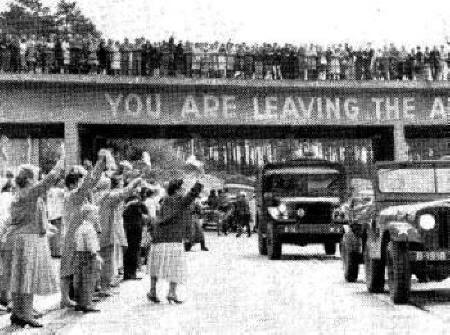 through East Germany to West Berlin. We were in a
crowd of Berliners who welcomed the military convoy as it entered West
Berlin. They excitedly cried out "Panzer!" (tank) when they saw armored
vehicles coming. Fortunately the communists chose not to oppose the military
convoy and the crossing was a successful assertion of the U.S. Military's
rights to travel the highway through East Germany. through East Germany to West Berlin. We were in a
crowd of Berliners who welcomed the military convoy as it entered West
Berlin. They excitedly cried out "Panzer!" (tank) when they saw armored
vehicles coming. Fortunately the communists chose not to oppose the military
convoy and the crossing was a successful assertion of the U.S. Military's
rights to travel the highway through East Germany.
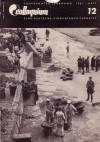 We watched as the communists began
building the wall through
the middle of Berlin. Pictures of tragic scenes flooded the media. People
were killed trying to escape over, around, or under the wall. Memorial
wreaths were laid near the wall where people had died. One day, we were
working in an area
near the wall We watched as the communists began
building the wall through
the middle of Berlin. Pictures of tragic scenes flooded the media. People
were killed trying to escape over, around, or under the wall. Memorial
wreaths were laid near the wall where people had died. One day, we were
working in an area
near the wall
 and noticed that workers were repairing and
strengthening the wall, including stringing barbed wire fencing near the
east side of the wall. The wall was not very high at that spot and I could
see over it. I tried to find our location on the Berlin street map, which I
always carried with me. I couldn't be sure where we were, so I called over
the wall to the workers and asked for the name of the street. One of the
workers had the courtesy to give me an answer. In a moment of impishness, I
called back, in German, "At home we build fences too, BUT FOR COWS!" The
next thing I knew, a brick came flying over the wall from East Berlin at me. and noticed that workers were repairing and
strengthening the wall, including stringing barbed wire fencing near the
east side of the wall. The wall was not very high at that spot and I could
see over it. I tried to find our location on the Berlin street map, which I
always carried with me. I couldn't be sure where we were, so I called over
the wall to the workers and asked for the name of the street. One of the
workers had the courtesy to give me an answer. In a moment of impishness, I
called back, in German, "At home we build fences too, BUT FOR COWS!" The
next thing I knew, a brick came flying over the wall from East Berlin at me. A uniformed West Berlin policeman must have been watching the
exchange, because he came hurrying our direction and asked us to leave,
which we did. I believe it was from that spot that I broke a
piece of masonry from the wall for a souvenir.
A uniformed West Berlin policeman must have been watching the
exchange, because he came hurrying our direction and asked us to leave,
which we did. I believe it was from that spot that I broke a
piece of masonry from the wall for a souvenir.
For a time we worked on the outskirts of West Berlin, near
where the city bordered East Germany. Armed guards patrolled the border and
its
tall, two-row barbed wire fence.
Guard towers
were placed at strategic
places along the fence.  It made the area look so much like a concentration camp that I
wanted to document it with photographs. I noticed that when I aimed my camera at
the guard tower, the armed guard would back away and turn so I could not
photograph his face. After taking several pictures, I got an idea. The next
time we came back into that neighborhood, I brought a pair of wire-cutting pliers. I
was determined to get a chunk of that barbed wire as a souvenir. I
approached the same location and got out my camera, pretending to be
photographing the guard tower. The guard turned away as I edged closer and
closer to the fence. It made the area look so much like a concentration camp that I
wanted to document it with photographs. I noticed that when I aimed my camera at
the guard tower, the armed guard would back away and turn so I could not
photograph his face. After taking several pictures, I got an idea. The next
time we came back into that neighborhood, I brought a pair of wire-cutting pliers. I
was determined to get a chunk of that barbed wire as a souvenir. I
approached the same location and got out my camera, pretending to be
photographing the guard tower. The guard turned away as I edged closer and
closer to the fence.
 As soon as I was close enough, I whipped out my pliers
and cut a length of
barbed wire off from the end of a loose strand of wire.
We discretely ended our "photography" session and made our departure. I
admired the huge barbs on that sample of Berlin barbed wire. Compared to our
standard American cattle-range barbed wire, they are wickedly
dangerous. As soon as I was close enough, I whipped out my pliers
and cut a length of
barbed wire off from the end of a loose strand of wire.
We discretely ended our "photography" session and made our departure. I
admired the huge barbs on that sample of Berlin barbed wire. Compared to our
standard American cattle-range barbed wire, they are wickedly
dangerous.
 My focus, as an LDS missionary, was to
help people of Berlin learn about my Church, My focus, as an LDS missionary, was to
help people of Berlin learn about my Church,
 but in the process I could see the
despair being felt by Berliners. I empathized with them. Evidence of the anguish was all around us.
Military armor often rumbled down the street
where we lived. Emotional
posters were but in the process I could see the
despair being felt by Berliners. I empathized with them. Evidence of the anguish was all around us.
Military armor often rumbled down the street
where we lived. Emotional
posters were everywhere. I collected
some posters and pamphlets that described
Berlin's tragedy. One 48 page pamphlet everywhere. I collected
some posters and pamphlets that described
Berlin's tragedy. One 48 page pamphlet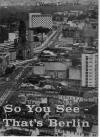 called
"Barbed
Wire Round Berlin" (PDF 5.01 MB) described historical details
of the crisis. A smaller one, called
"So You See - That's Berlin"
(PDF 0.55 MB) described the frustrations of life in divided Berlin. called
"Barbed
Wire Round Berlin" (PDF 5.01 MB) described historical details
of the crisis. A smaller one, called
"So You See - That's Berlin"
(PDF 0.55 MB) described the frustrations of life in divided Berlin.
We missionaries were committed to early morning study before we went out contacting people. I had a windup alarm clock, which didn't always wake me up. So I rigged it up to turn on a little transistor radio. I took the 9 volt battery out of the radio, unhooked one of the electrical contacts. I slid a small piece of paper between the contact and the battery to prevent an electrical contact. Then I attached one end of a string to the paper slip and the other end of the string to the mechanical winder of the alarm clock. When the alarm went off at 6:00 A.M. the winder turned round and round, winding the string up on its stem. The shortening string pulled the paper slip away from the battery, so electrical contact was made and the radio began playing.
 I also had a reel-to-reel tape recorder. One morning I recorded our wake-up music from the Armed Forces Network in Berlin. It also gave us a bit of news from back home in the United States. The recording date was November 6, 1962, which happened to be Election Day. The first music of the day was always "Hymns from Home." My missionary companion was Elder Tom Lomax. We were living in an apartment in the Berlin-Neukoelln area. The recording included my contemporary commentary. You can listen to an abbreviated (less than 7 minute) version of the recording by clicking on the controller bar: I also had a reel-to-reel tape recorder. One morning I recorded our wake-up music from the Armed Forces Network in Berlin. It also gave us a bit of news from back home in the United States. The recording date was November 6, 1962, which happened to be Election Day. The first music of the day was always "Hymns from Home." My missionary companion was Elder Tom Lomax. We were living in an apartment in the Berlin-Neukoelln area. The recording included my contemporary commentary. You can listen to an abbreviated (less than 7 minute) version of the recording by clicking on the controller bar:
[Top]
[Home]
|